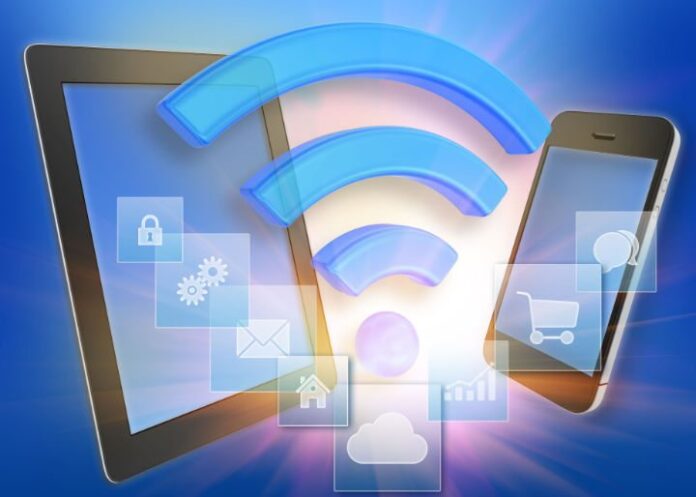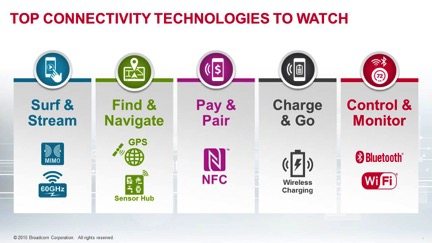With the “Internet of Things” reaching into every aspect of modern life, analysts predict the number of connected devices to reach around 5 billion by the end of this year – up 30% from 2014. By the end of the decade, that number is expected to reach nearly 40 billion, far exceeding the number of people on the planet.
At the heart of the IoT are the connectivity technologies that make it possible. Let’s take a closer look at the top five emerging connectivity technologies to watch in 2015 and beyond.
Surf and stream with 802.11ac and 802.11ad Wi-Fi
At the top of the list is the combined surf-and-stream capabilities enabled by two emerging wireless technologies – 802.11ac in the 5 GHz band and 802.11ad in the 60 GHz band.
With consumers streaming more and more content, being able to connect over a robust wireless connection is critical. 802.11ac Wi-Fi brings a number of new features to connectivity that weren’t possible just two years ago. It allows media streaming from a handset to a digital television at data rates comparable to Ethernet, high-speed data and media synchronization, and significantly improves the Wi-Fi user experience by reducing signal fading and lost connections while increasing range.
Add 2×2 multiple-input/multiple-output transmission capabilities to the mix and 802.11ac Wi-Fi performance becomes even more powerful. 2×2 MIMO can transmit or receive two data streams concurrently over two antennas, doubling throughput and enabling much faster download times. This puts smartphone performance on equal footing with the connectivity technology available in laptops and tablets, something that until now has not been possible.
For in-room communication 802.11ad shines. The true magic of 802.11ad is the wide available bandwidth of 60 GHz that allows data rates of up to 7 gigabits per second. A range of up to 12 feet makes 802.11ad Wi-Fi perfect for in-room, point-to-point applications such as wireless connectivity between a mobile device and the TV. Tri-band solutions incorporating 802.11ac and 802.11ad will deliver a seamless experience using whatever works best for a particular distance and application, allowing consumers to surf and stream at lightning fast speeds.
Find and navigate with GNSS and sensor hub technologies
Wearable devices, such as the fitness trackers, bands and watches – are only as useful as the data they collect. The accuracy of the data, such as miles run or calories burned is crucial. Relying on GPS or a GNSS receiver alone to calculate a route or speed while running can be wildly inaccurate.
This year will see the convergence of technologies working together to more accurately track and manage data. By combining sensor hub, GNSS, Bluetooth Smart and Wi-Fi technologies, today’s wearable devices can deliver more accurate results while preserving battery life.
Data from the combined technologies can recognize when a runner is outdoors versus inside on a treadmill and dynamically manage these technologies to save battery life and optimize the user experience.
Charge and go with resonant wireless charging
When we went wireless for data, we only got half way to “cutting the cord.” The average U.S. household still connects via a rat’s nest of cables to charge up to 10 devices at any one time. Wireless power, which allows users to charge electronic devices without the use of a cable, promises to finally cut the cord for good. While wireless power technology has been around for some time, its evolution from first-generation inductive technology to second-generation resonant technology is now promising to take it mainstream with its capability to charge multiple devices at the same time.
Resonant wireless technology features a simple transmitter antenna design for multiple receiver support, a comprehensive wireless power control system using Bluetooth Smart communication, and has the ability to transfer power through non-metallic surfaces. This means that even the smallest of devices, such as headsets and wearables, can communicate clearly and intelligently with the charging surface.
Imagine what that capability will mean for retailers and consumers. Wireless charging stations will start popping up everywhere from home furnishings to coffee shops, airports, restaurants and movie theaters, providing consumers with a true charge-and-go experience.
Pay and pair with NFC
Near-field communications technology, which allows two devices to pair or share data simply by touching them together – has already made an impact in the world of mobile payments. NFC is quickly gaining traction in other consumer applications, providing a more personalized experience with the IoT, especially for home automation and the connected car.
A driving force behind the IoT is the idea of connecting all the devices in a room into a single ecosystem. NFC’s tap-to-connect feature simplifies the set-up process between a smartphone and a variety of other devices including the TV, portable speaker or the car, without a complicated set up process.
According to recent analyst reports, a vast majority of mobile devices are incorporating NFC technology as a de facto standard, as consumers become increasingly aware of the benefits of mobile payments and NFC wireless readers proliferate in businesses around the world.
Control and monitor with Wave 2 Wi-Fi and Bluetooth Smart
Together, 802.11ac Wave 2 Wi-Fi and Bluetooth Smart are behind an explosion of control and monitoring applications within the context of the IoT, enabling improvements in everything from industrial automation to home energy and medicine.
802.11ac Wave 2 technology has raised the bar on Wi-Fi performance, allowing multiple Wi-Fi devices to connect simultaneously. This allows the router or gateway to support substantially more devices at the same time, meeting varied data and video needs seamlessly. Meanwhile, ultra-low-power Bluetooth Smart-enabled devices connect to the Internet via those same gateways for highly secure data connectivity to the cloud.
That data will be analyzed and useful, actionable intelligence will be extracted to make the monitored device or activity better over time. The potential of this constant, data-based improvement over time can hardly yet be imagined.
Lewis Brewster serves as Broadcom’s VP and GM of Wireless Connectivity. In this role, he is responsible for expanding Broadcom’s wireless connectivity leadership in consumer and enterprise markets. Brewster holds a BSEE in Electrical and Biomedical Engineering from Duke University and an MBA from Stanford University. Reach the author @broadcom.
Editor’s Note: In an attempt to broaden our interaction with our readers we have created this Reader Forum for those with something meaningful to say to the wireless industry. We want to keep this as open as possible, but we maintain some editorial control to keep it free of commercials or attacks. Please send along submissions for this section to our editors at: dmeyer@rcrwireless.com.


